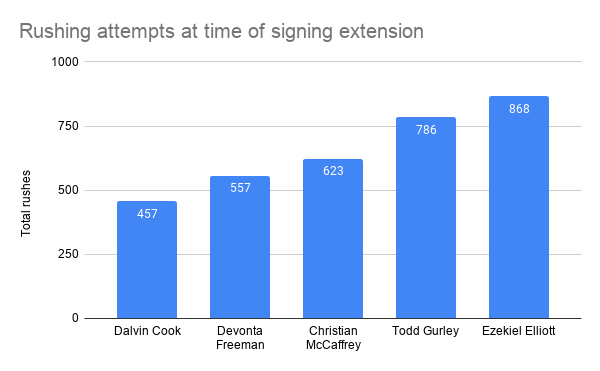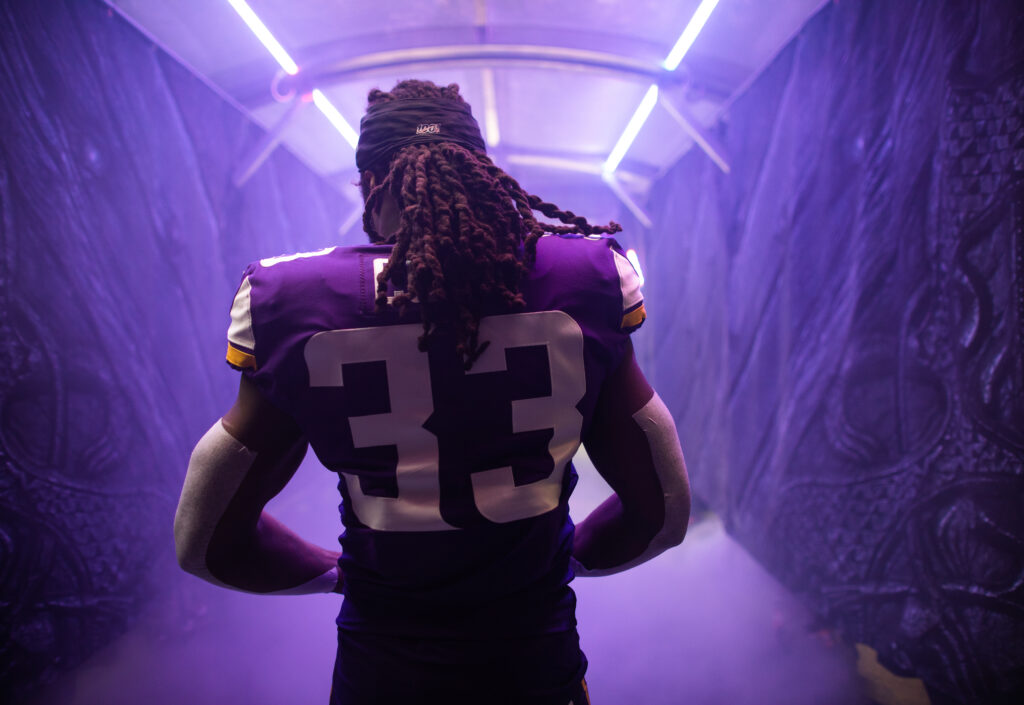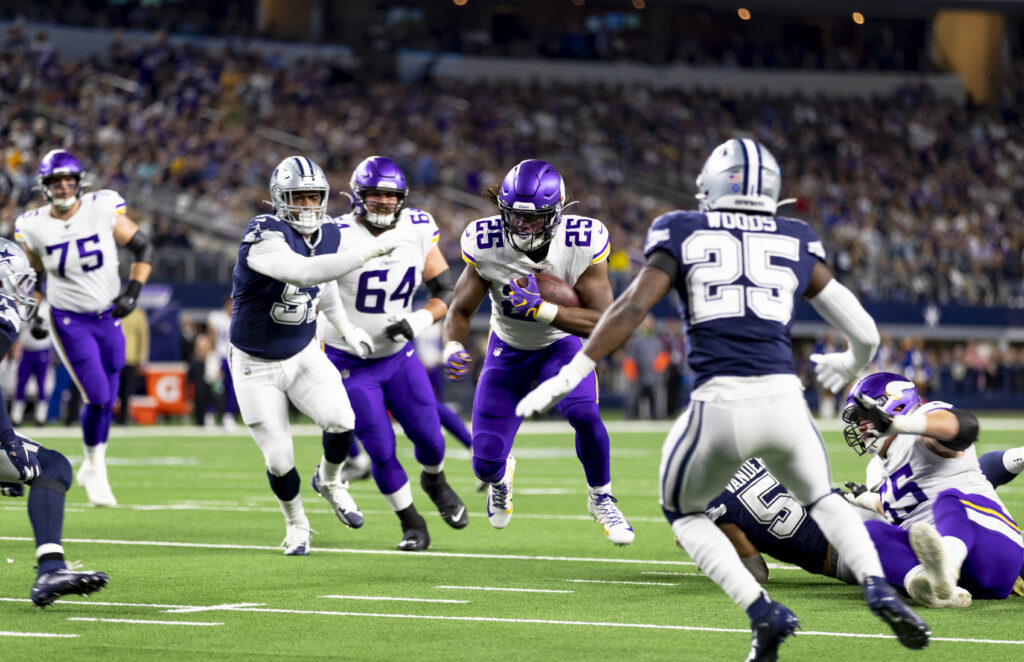
Matthew Coller is an experienced football writer who covered the Vikings for 1500ESPN and Skor North for four years. He is now writing a weekly Vikings column for Bring Me The News, and you can find more of his work at Purple Insider.
If you like football and have an internet connection, you have probably noticed that there is a non-stop debate over the value of running backs.
If you stand on the side that running backs are replaceable and feel that no team should ever sign one to a contract extension, you have plenty of ammo after the last few months. In February the teams represented in the Super Bowl had their ground game led by the likes of Raheem Mostert and Damien Williams, neither of whom made more than $2 million in 2019 for their services.
And when the offseason came around, two of the highest paid running backs, Todd Gurley and Devonta Freeman, were cut by their teams. The Rams will carry a dead cap hit over $20 million this year for their miscue and Atlanta have $6 million in dead space for Freeman. Not long ago they both dominated. Atlanta’s star had 27 touchdowns between 2015 and 2016 and Gurley was voted an All-Pro in 2017 and 2018.
All that is enough to make Minnesota Vikings fans pretty nervous about an inevitable contract extension on the way for running back Dalvin Cook.
While it may work counter to the modern way of viewing the running back position, paying top dollar for Cook isn’t as frightening as the Gurley and Freeman busts might suggest.
Podcast: Behind the Vikings miracle 2017 season: Pt. 1, training camp
Podcast: Behind the Vikings miracle 2017 season: Pt. 2, Bradford goes off
Podcast: Behind the Vikings miracle 2017 season: Pt. 3, Keenum’s magic ride begins
Podcast: Behind the Vikings miracle 2017 season, Pt. 4, Teddy time
Vikings’ future cap situation
Few teams in the NFL entered this offseason as cap-strapped as the Vikings. In order to get out of the red, they signed Kirk Cousins to a contract extension that lowered his 2020 cap hit, cut Xavier Rhodes and Linval Joseph and let Trae Waynes and Mackensie Alexander walk in free agency. And after all that, they only had enough space to muster one signing, a three-year, $27 million contract for nose tackle Michael Pierce.
The Vikings have around $12 million in space according to OverTheCap but once they sign their 15-man draft class and agree to an extension with Cook that will raise his cap hit in 2020, the front office will have just about enough to sign a veteran to a minimum contract.
By the time March 2021 rolls around, the Vikings’ cap situation will look vastly different.
Some quick math: Per OTC, the Vikings currently have $182 million in contracts for 2021. All the players drafted this year will still be on their rookie contracts next season, so add another $10 million for those players and they are still around $20 million underneath the projected cap. That’s without releasing anyone or restructuring any deals.
With the Vikings picking left tackle Ezra Cleveland in the second round, odds are that Riley Reiff will be let go, creating $11.8 million in space. There is a good chance Kyle Rudolph, who is set to carry a $9.5 million hit into 2021, is either cut or reworks his contract to be more team friendly.
It doesn’t seem likely that Anthony Barr will play on a $15.5 million cap hit either. The only player in need of an extension will be tackle Brian O’Neill.
The Vikings will go from one of the tightest cap situations to one of the best. Not only can they afford to fit a market-rate cap hit for Dalvin Cook under the cap, they are very likely to have the flexibility to make a big signing in free agency.
How will it change so quickly? Cornerbacks. In 2019 the Vikings spent $27 million in cap space on cornerbacks, fourth most in the NFL. In 2021 they are projected to spend $7.2 million. The draft picks of Jeff Gladney and Cameron Dantzler combined with 2018 first-round pick Mike Hughes entering the final year of his rookie deal equate to the Vikings spending almost nothing on a position that’s generally very expensive.
They will also have a starting left tackle on a rookie deal if Cleveland works out and a No. 2 receiver in Justin Jefferson who’s making minimal money compared to his expected role.
If Cook signs a five-year deal that the Vikings can restructure or walk away from after three years, that will match up with the time that players like Gladney, Cleveland and Jefferson need to get paid.
Production, milage
We love to pick out the undrafted players who suddenly become star running backs as evidence that anybody with two legs can be plugged into a system and run wild. It’s certainly true that there is an abundance of talent in the backfield in today’s NFL but since 2010 there are only 13 players drafted past the fourth and six undrafted players round to register 1,000-yard seasons.
Make no mistake, the shrewd approach is probably to build a monster offensive line and find three backs who can handle different roles but how many teams have that luxury? Cook was asked to overcome his offensive line play on many occasions during his first three years as a pro. Last year Cook ranked sixth in Pro Football Focus’s “Elusive Rating” statistic that factors missed tackles and yards gained after contact among running backs with at least 240 rushes.
Despite mediocre O-line play since he entered the league, Cook ranks 15th in yards per carry out of 87 running backs with more than 450 carries since 2010 at 4.60 yards per attempt — which is 0.02 behind Dallas superstar Ezekiel Elliott.
He also led the NFL in yards after reception in 2019 and has a higher yards per catch rate than Elliott and do-it-all backs Alvin Kamara and Christian McCaffrey.
And the numbers point more toward his ability to sustain a high level of play through his next contract than against it. Age curves show the dip in production begins around age 27. Cook will be 25 in August.
Since he has missed time each of the first three years, injuries are a natural concern. However, assuming that his ACL tear will not have long-term ramifications and last year’s shoulder injury was simply bad luck, Cook may benefit from having a smaller workload than other star backs when they received their extensions. Here’s how they compare:

What will an extension look like?
There should be a fair middle ground between the Vikings and Cook.
“If I were his agent I would start at four years, $55 million,” OverTheCap’s Brad Spielberger said. “Above the David Johnson market but in the second tier running back market. When we say Gurley and those guys jump, Johnson was just below. I don’t think Cook is going to threaten the McCaffrey or Ezekiel Elliott market because of injuries but he’s right in that second tier.”
The Vikings have generally signed star players who they drafted to five-year extensions that really more like three-year deals. Based on that past history, a new deal would bump his cap hit up in 2020 only marginally and then it would take significant jumps in Year 2 and 3.
“One thing that I think is good about the way the Vikings normally structure deals is that they tend to not prorate a lot of money,” Spielberger said. “Smaller signing bonuses, which in effect means less money pushed down the line.”
Certainly there is a case to be made that the risk is too high and drop-offs are too harsh so teams should always let their star running backs walk in free agency. But in Cook’s case, a deal is less worrisome when put under a microscope.
If he stays healthy and plays 14-16 games per season, the Vikings won’t regret paying their most dangerous offensive weapon during a period in which they expect to be in the playoffs each year.
Coller: Rebuilding cornerback group may be Mike Zimmer’s greatest challenge










